Designing a garden for beginners can be a fun and rewarding project. It may seem intimidating, but with a step-by-step approach, anyone can create a beautiful outdoor space. The first step is to determine the style of garden that complements your home, whether it’s a minimalist garden or a cottage garden. Consistency in style is important throughout the front and backyard.
Creating outdoor rooms within the garden, such as a patio or a shaded area, adds functionality and structure. Beginners should focus on three design principles: scale, color, and plant groupings. Understanding plants’ mature height and width is crucial for proper spacing and avoiding overcrowding. Selecting a color palette of 1-3 colors for each section of the garden creates harmony and contrast.
Plant groupings should mimic nature, with plants arranged in drifts rather than straight rows. It’s essential to consider how you want to use your garden and who will be using it. Whether it’s for relaxation, entertainment, or attracting pollinators, these factors will influence the design.
Testing the soil and ensuring it is healthy is vital for successful gardening. Knowing the pH level and chemical properties of the soil can help determine which plants will thrive. Choosing between seeds and transplants depends on personal preference and the level of care required.
Containers and raised beds are suitable options for beginners, and various materials can be used, including recycled items or building wooden containers. With these guidelines, beginners can start their garden and enjoy the process of watching it grow.
Key Takeaways:
- Choose a garden style that complements your home’s architecture
- Create outdoor rooms to add functionality and structure
- Focus on three design principles: scale, color, and plant groupings
- Understand plant sizes for proper spacing and avoiding overcrowding
- Select a color palette of 1-3 colors for each section of the garden
- Mimic nature with plant groupings arranged in drifts
- Consider the intended use of the garden and who will be using it
- Test soil and ensure it is healthy, with the correct pH level and chemical properties
- Choose between seeds and transplants based on personal preference and level of care required
- Containers and raised beds are suitable options for beginners, with various materials to choose from
Choosing the Right Garden Style to Complement Your Home’s Architecture
To start, it’s important to choose a garden style that complements your home’s architecture. This is a crucial step in creating a cohesive and visually pleasing outdoor space. Your garden should be an extension of your home, reflecting your personal style and taste. As a beginner, you may be overwhelmed by the variety of garden styles available, but don’t worry, I’m here to guide you through the basics.
The first step in choosing a garden style is to consider the style and architecture of your home. Certain garden styles may clash or look out of place with your home’s design. For example, a formal French garden may not pair well with a rustic cottage-style home, while a wildflower garden may not complement a modern architecture. When choosing a garden style, you should also consider how you plan to use your garden. Do you want a space for relaxation, entertaining, or growing vegetables and herbs? Your garden’s function should reflect your needs and lifestyle.
Here are some popular garden styles to consider:
| Garden Style | Description |
|---|---|
| English Garden | A classic style featuring a mix of perennials, annuals, and shrubs, with a focus on symmetry and balance. |
| Japanese Garden | A minimalist style featuring clean lines, simple plantings, and water features. |
| Cottage Garden | A charming style featuring a mix of flowers, herbs, and vegetables, with a focus on a relaxed, natural aesthetic. |
| Modern Garden | A contemporary style featuring clean lines, bold shapes, and minimal plantings, with a focus on functionality and simplicity. |
Once you’ve chosen your garden style, it’s important to stay consistent throughout both the front and back yards. This will help create a unified look and feel, making your garden a seamless extension of your home. You can differentiate various areas of your garden by creating outdoor rooms. These spaces can be defined by features such as patios, privacy screens, or shade structures, and can add depth and functionality to your outdoor space.
Lastly, when designing your garden, focus on three essential design principles: scale, color, and plant groupings. Understanding the mature height and width of plants is crucial for scaling them correctly in the garden. Creating a color palette for each section of the garden and considering contrast can help achieve a harmonious look. Plant groupings should mimic nature, with odd numbers of perennials and annuals grouped together in natural-shaped clumps and sweeps. By considering these basic design principles and your personal preferences, you can create a beautiful and functional garden that complements your home’s architecture and reflects your unique style.

Creating Outdoor Rooms for Cozy and Spacious Areas
Creating outdoor rooms within your garden can provide cozy and spacious areas to relax. An outdoor room is an area that is defined by a floor (such as a patio), at least one wall (such as a privacy screen or walls), and a roof (such as a shade structure, shade tree, or umbrella).
When designing your outdoor room, think about how you want to use the space. Do you want to create a dining area, a reading nook, or a place to entertain guests? Consider the needs of the people and animals who will be using the space. For example, if you have children or pets, you may want to include a play area or a pet-friendly feature.
Keep in mind that the scale, color, and plant groupings are important aspects of garden design. Scale refers to the mature size of plants and garden beds, so make sure that you choose plants that won’t outgrow their space or overpower the other plants in the area. Color should be chosen carefully to create a harmonious palette. Plant groupings should mimic nature, with plants arranged in drifts and grouped by water needs.
By incorporating these principles into your outdoor room design, you can create a beautiful and functional space that complements your home’s architecture and meets your specific needs. Before you start designing, make a list of the three design elements that are most important to you. This will help guide your choices and ensure that your outdoor room is everything you want it to be.
| Easy Garden Design Tips for Beginners: |
|---|
| Tip 1: Use outdoor rugs and furniture to define the space and create a sense of coziness. |
| Tip 2: Incorporate lighting to extend the use of the space into the evening. |
| Tip 3: Add water features such as a fountain or birdbath to create a relaxing atmosphere. |
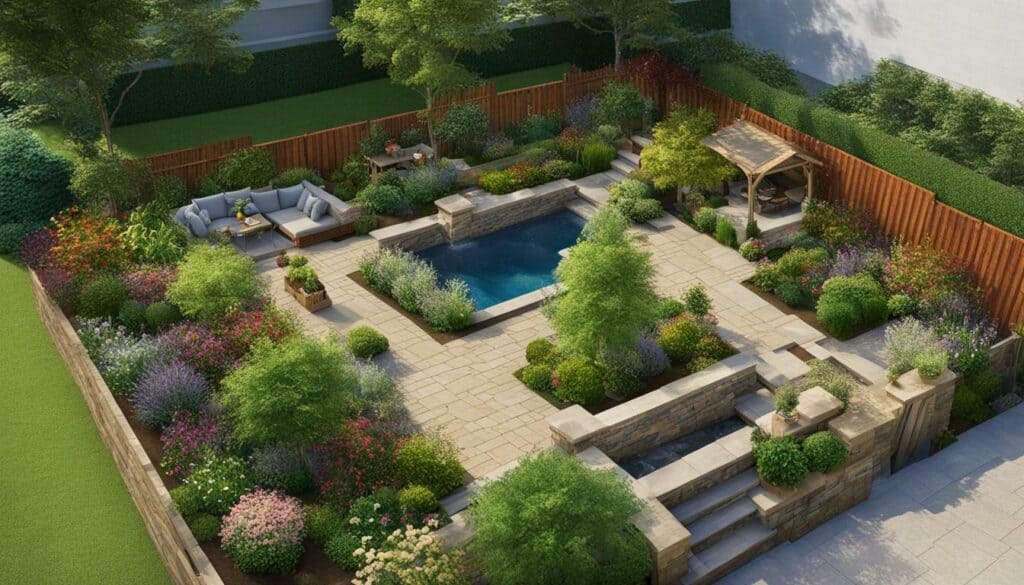
Key Design Principles for Beginners: Scale, Color, and Plant Groupings
Beginners should focus on three design principles: scale, color, and plant groupings when designing their garden. Each of these principles plays an important role in creating a visually stunning and functional outdoor space.
| Design Principle | Description |
|---|---|
| Scale | Understand the mature size of plants and plan accordingly. Avoid planting large trees in small spaces and choose plants that fit the size of your garden. Consider the height and width of plants and leave space for them to grow. Use trees and shrubs to anchor the garden and create a sense of depth. |
| Color | Select a color palette of 1-3 colors for each section of the garden. Choose plants that contrast with their background and complement each other. Too much or too little color can be distracting. Use color to create a mood and draw the eye to specific areas of the garden. |
| Plant Groupings | Group plants in natural-shaped clumps and drifts to mimic nature. Avoid straight rows and plant odd numbers of plants together to create large sweeps of color. Group plants by water needs and include groundcover plants as a “living mulch”. |
Understanding these key design principles is important for beginners to create a beautiful and functional garden space. Garden design for first-time gardeners can be a daunting task, but by focusing on these design principles, beginners can create a garden that is visually appealing and meets their needs. By considering the intended use of the garden and the needs of the people and animals who will use it, beginners can ensure their garden is not only beautiful but also functional and accessible.

Whether starting a garden for the first time or redesigning an existing one, garden design for beginners requires planning, patience, and attention to detail. By following these step-by-step garden design for beginners tips, first-time gardeners can create a garden that is both beautiful and functional. By incorporating these design principles into their garden, beginners can create an outdoor space that is a reflection of their personal style and meets their needs.
Understanding Plant Sizes for Proper Placement
Understanding the mature height and width of plants is crucial for proper placement in a garden, especially for beginners. Choosing plants that are too large for the space will result in an overwhelmed garden, while small ones can get lost. As a general rule of thumb, taller plants should be placed towards the back of the garden, while shorter ones should be towards the front.
When starting a garden for beginners, it’s important to consider the garden’s purpose, the available sunlight, and the needs of the users. Container gardening or raised beds are great options for those with limited space or poor soil conditions. These methods also provide better control over soil quality, pests, and water.
Another essential step is to ensure healthy soil. Healthy soil is the foundation of a thriving garden. Testing the soil before planting can help identify any deficiencies such as pH imbalances or nutrient deficiencies. It’s also a good idea to add organic matter such as compost or manure to improve the soil quality.
When designing a beginner-friendly garden landscaping, the key design principles of scale, color, and plant groupings are important. Choosing plants that complement the style of your home and creating outdoor rooms with specific purposes and design elements helps to establish a harmonious and functional space.
Whether you choose to start with seeds or transplants, it’s important to have a vision for your garden based on your space. Choosing plants that thrive in your region and planting them at the right time of year can also improve your chances of success.
With these expert tips, starting a garden for beginners is easy and enjoyable. With proper planning, healthy soil, and an eye for design, anyone can create a beautiful and thriving garden that brings joy and satisfaction for years to come.
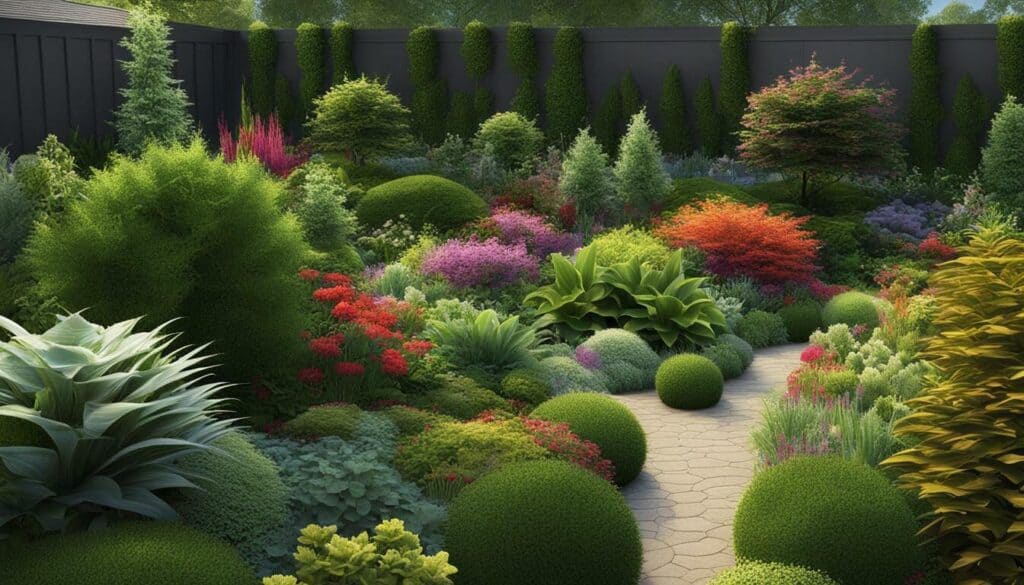
Creating a Harmonious Color Palette for Visual Appeal
Creating a color palette of 1-3 colors for each section of the garden can create visual harmony. When selecting a garden style, it’s important to consider the style of your house and ensure that it complements the overall look. Consistency in style between the front yard and backyard is also crucial.
When selecting colors for your garden, it’s important to create a palette and stick to it when selecting plants. This will avoid a chaotic and overwhelming effect. Contrast is also important, so plants in front of a fence or wall should contrast with the background.
The color palette can also be designed to create a specific mood, with cool colors like blues and greens creating a relaxing atmosphere, and warm colors like yellow, orange, and red energizing the space.
Another important principle is to plant in drifts rather than straight rows, mimicking nature and creating beautiful sweeps of color.
Additionally, it’s essential to consider how you want to use your garden and who will be using it. This will help determine the layout, whether you need privacy screens or play areas, and what type of plants to include.
Overall, creating a harmonious color palette is an important aspect of garden design that can greatly enhance the visual appeal of your outdoor space.

Mimicking Nature’s Beauty with Grouped Plantings
Grouping plants in natural-shaped clumps and drifts can mimic nature and create a more visually appealing garden design. When planning your garden, consider how plants would grow in their natural environment and try to replicate that in your design. This can be achieved by planting larger groups of the same species or arranging plants in a way that mimics natural patterns.
For example, instead of planting one or two tulips in a row, plant them in a natural-shaped clump to create a more organic look. This will also create a larger swath of color in the garden, which can be more visually striking than scattered blooms.

When grouping plants, think about the colors, textures, and shapes of the plants. Varying these elements within the groupings can create a more dynamic and interesting look. Additionally, consider the needs of the plants when grouping them. For example, plants with similar water needs should be grouped together to make watering easier.
Grouping plants is not only aesthetically pleasing, but it can also help with weed control and moisture retention. By planting groupings of groundcovers, you can effectively choke out weeds and reduce the need for herbicides. Additionally, groupings of plants can create a microclimate that helps retain moisture and provide shelter for beneficial insects.
Overall, mimicking nature’s beauty with grouped plantings is an easy and beginner-friendly garden design tip that can transform your garden into a beautiful and functional space.
Designing for Functionality and Accessibility
Before designing your garden, consider how you want to use the space and who will be using it. Creating a garden that is beautiful and functional requires careful planning and consideration of various factors. When starting a garden for beginners, it is important to design for functionality and accessibility to ensure that everyone can enjoy the space.
One of the first things to consider is the garden style that complements the architecture of your home. Whether it is a formal garden, cottage garden, or zen garden, the style you choose should create a cohesive design that enhances the beauty of your home. Additionally, consider creating outdoor rooms with designated areas for relaxation, privacy, and shade. This can enhance the functionality of the garden and provide a space for every occasion.
When designing, it is crucial to consider the scale of plants, color palettes, and plant groupings. For example, taller plants should be planted at the back of the garden while shorter plants should be planted at the front to create a sense of depth and dimension. Additionally, consider using a harmonious color palette for each section of the garden to achieve visual harmony. Grouping plants in natural-shaped clumps and drifts can also mimic nature’s beauty in garden design.
| Tip: | Testing the soil and ensuring it is healthy is another factor to consider when designing a garden for functionality and accessibility. A soil test can determine the soil pH and provide nutrient recommendations for the specific plants you want to grow. |
|---|
Furthermore, designing the garden based on how it will be used and considering the needs of the users is essential. For example, if you have children or pets, consider creating paths and designated play areas. For individuals with physical impairments, consider raised beds or containers for easier access. Choosing between seeds or transplants and utilizing containers or raised beds are other factors to consider when designing a garden for beginners.
By designing for functionality and accessibility, you can create a beautiful and functional garden that everyone can enjoy. Consider these factors when starting a garden for beginners and you’ll be on your way to creating a space that’s both beautiful and useful.
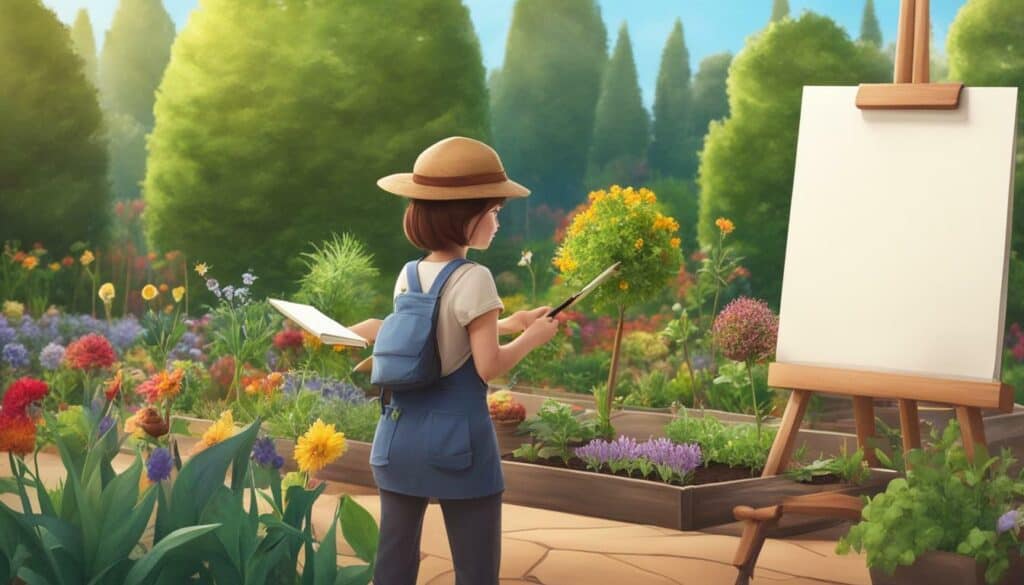
Identifying Your Priorities: Three Key Design Elements
When designing a garden, it is important to consider what you want to prioritize in your space. Do you want a garden that is primarily for relaxation, entertainment, attracting wildlife, or providing privacy? Once you have identified your top three priorities, you can use them as a guide throughout the design process.
Additionally, you should consider the space available for your garden and the amount of sunlight it receives. This will help determine the type and size of the garden beds you can create. Testing the soil for proper texture, structure, and pH level is crucial to ensure healthy plant growth. Whether using seeds or transplants, it is important to give plants enough space to grow and thrive. Containers or raised beds can be used for gardening and can be made from various materials, as long as they are safe for plants.
When considering the design of your garden, there are three key elements to keep in mind that will help you create a cohesive and visually appealing space: style, outdoor rooms, and plant groupings.

- Style: The style of your garden should complement the style of your home and be consistent throughout the front and backyard. Do you prefer a formal or informal garden? Classic or modern? Take cues from the architecture of your home and select a style that aligns with it.
- Outdoor Rooms: Creating outdoor rooms with designated spaces for relaxation, privacy, and shade adds depth and functionality to your garden. Think of your garden as an extension of your home, with distinct areas for different activities.
- Plant Groupings: When selecting plants, it is important to consider their mature height and width for proper scale in the design. A color palette of 1-3 harmonious colors should be chosen to avoid an overwhelming or dull look. Planting in drifts and grouping plants by their water needs mimics nature and creates a visually pleasing design.
Finally, make a list of the three design elements that are most important to you and use them as a guide throughout the design process. With these key design elements in mind, you can create a beautiful and functional garden that complements your home and reflects your personal style and priorities.
Putting It All Together: Step-by-Step Garden Design for Beginners
Now that you have a solid foundation in garden design principles and considerations, it’s time to put it all together with a step-by-step approach. Here’s how to design a garden for beginners:
Step 1: Choose Your Garden Style
Start by choosing a garden style that complements your home’s architecture. Consider factors like the amount of sun exposure, soil type, and water availability when selecting plants. Research different garden styles and choose one that suits your tastes and needs.
Step 2: Sketch Out A Plan
Draw a rough sketch of your garden area, including any existing features like trees or fences. Determine the placement of outdoor rooms and major plant groupings. Consider the size of each plant at maturity to ensure proper spacing.
Step 3: Plan for Functionality and Accessibility
Think about how you want to use your garden and who will be using it. Plan for accommodations for pets, children, and individuals with physical impairments. Consider adding features like paths, raised beds, and containers.
Step 4: Prepare Your Soil
Start with healthy soil by buying quality soil or composting at home. Test your soil to determine any deficiencies and amend as necessary. Ensure proper drainage by adding organic matter.
Step 5: Choose Your Plants
Select plants based on your gardening zone and the amount of sun and water they require. Consider the height and spread of each plant at maturity and group them according to their needs. Plant seeds or use transplants.
Step 6: Add Features and Accessories
Add finishing touches to your garden with features like patios, walls, and shade structures. Install irrigation or water features as desired. Choose accessories like furniture and lighting to enhance your outdoor spaces.
Step 7: Maintain Your Garden
Maintain your garden by regularly watering, fertilizing, and pruning. Monitor for pests and diseases and treat as necessary. Take time to enjoy the physical and mental health benefits of gardening.
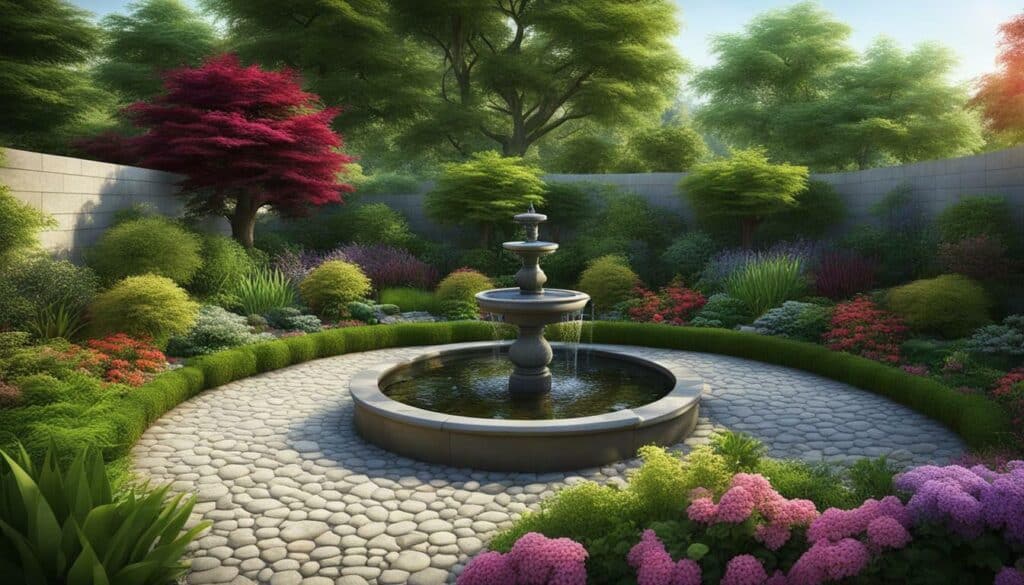
Follow these steps to design a garden that is both beautiful and functional. With a little planning and effort, you can create an outdoor space that you’ll enjoy for years to come.
Conclusion
Designing a garden for beginners is an exciting journey that allows you to unleash your creativity and create a beautiful outdoor space. By choosing the right garden style, creating outdoor rooms, understanding key design principles, and designing for functionality, you can create a beginner-friendly garden that complements the architecture of your home and provides cozy and spacious areas for relaxation.
Remember, identifying your priorities and following a step-by-step guide can help you successfully begin your gardening journey. Gardening offers numerous health benefits, from being outdoors and getting Vitamin D to enjoying the fresh produce you grow. So, don’t let your space go to waste, and start gardening today!
FAQ
Q: Can I design a garden if I’m a beginner?
A: Yes, designing a garden for beginners can be a fun and rewarding project. With some guidance and the right principles, anyone can create a beautiful garden.
Q: How do I choose a garden style for my home?
A: To choose the right garden style, consider the architecture of your home and find a style that complements it. There are various garden styles to choose from, such as English cottage gardens or modern minimalist designs.
Q: What are outdoor rooms in a garden?
A: Outdoor rooms are designated areas within a garden that provide cozy and spacious areas for relaxation. They can be created using furniture, plants, and hardscape elements to define the space.
Q: What are the key design principles for beginners?
A: Beginners should focus on three key design principles: scale, color, and plant groupings. Understanding how plants grow in size, choosing a color palette, and grouping plants in natural-shaped clumps can create a harmonious and visually appealing garden.
Q: Why is understanding plant sizes important in garden design?
A: Understanding the mature height and width of plants is crucial for proper placement in the garden. This ensures that plants won’t outgrow their space and that the garden maintains a balanced and cohesive look.
Q: How can I create a harmonious color palette in my garden?
A: Creating a color palette of 1-3 colors for each section of the garden can create visual harmony. Choose colors that complement each other and consider the overall mood or theme you want to achieve.
Q: What does it mean to mimic nature’s beauty with plant groupings?
A: Mimicking nature’s beauty involves grouping plants in natural-shaped clumps and drifts, rather than arranging them in rigid patterns. This creates a more organic and natural look in the garden.
Q: Why is functionality and accessibility important in garden design?
A: It’s important to consider how you want to use your garden and who will be using it. Providing access, privacy, and accommodations for pets, children, and individuals with physical impairments ensures that the garden is functional and inclusive.
Q: How can I identify my priorities in garden design?
A: Make a list of the three design elements that are most important to you, such as color, plant variety, or a specific theme. These priorities will guide you throughout the design process and help you make decisions.
Q: What should I consider when putting together a garden design?
A: When putting together a garden design, consider all the principles and considerations discussed in this guide. Incorporate the right garden style, create outdoor rooms, apply key design principles, understand plant sizes, create a color palette, mimic nature’s beauty, consider functionality and accessibility, and keep your identified priorities in mind.
Q: Can you provide a step-by-step guide for designing a garden as a beginner?
A: Yes, the article provides a step-by-step guide on designing a garden for beginners. It incorporates all the principles and considerations discussed to help you create a successful garden design.
What Are the Key Steps to Designing a Garden for Beginners?
Designing a garden can be a rewarding and enjoyable task, especially for beginners. To create easy garden designs for beginners, start with careful planning and research. Consider the available space, soil type, and desired plants. Choose a focal point, such as a beautiful flower bed or a cozy seating area. Determine the ideal layout and incorporate elements like pathways, containers, and trellises. Remember to consider maintenance needs and the climate to ensure a successful garden.
Source Links
- https://simplysmartgardening.com/garden-design-how-to/
- https://commonsensehome.com/start-a-garden/
- https://www.npr.org/2020/04/17/837300800/this-is-a-good-time-to-start-a-garden-heres-how
- https://www.bhg.com/gardening/yard/garden-care/ten-steps-to-beginning-a-garden/
- https://www.prettypurpledoor.com/design-a-garden-layout/
- https://gardeningsolutions.ifas.ufl.edu/design/ten-planning-tips-for-design.html
- https://www.almanac.com/landscape-design-ideas-and-advice-beginners
- https://www.prettypurpledoor.com/garden-styles/
- https://green-weaver.com/create-outdoor-rooms/
- https://www.prettypurpledoor.com/garden-rooms/
- https://www.thespruce.com/landscape-design-for-beginners-2130815
- https://edis.ifas.ufl.edu/publication/MG086
- https://edis.ifas.ufl.edu/publication/EP449
- https://www.almanac.com/vegetable-gardening-for-beginners
- https://www.planetnatural.com/garden-planning/
- https://extension.uga.edu/publications/detail.html?number=B1396&title=landscape-basics-color-theory
- https://www.prettypurpledoor.com/garden-color-schemes/
- http://extension.msstate.edu/using-color-the-landscape
- https://stylebyemilyhenderson.com/blog/what-is-a-native-garden-how-do-you-create-a-garden-color-palette
- https://www.homesandgardens.com/gardens/naturalistic-planting-design
- https://www.gardeners.com/how-to/garden-design-basics/5165.html
- https://www.houseandgarden.co.uk/gallery/designing-a-garden
- https://kidsgardening.org/resources/lesson-plan-design-accessible-garden/
- https://extension.okstate.edu/fact-sheets/homeowner-garden-design-series-elements-and-principles-of-design.html
- https://www.dreamzar.app/post/garden-design-basics-101-a-beginner-s-guide
- https://www.architecturaldigest.com/story/landscape-design-basics-everything-you-need-to-know
- https://www.countryliving.com/gardening/garden-ideas/g746/garden-plans/
- https://www.bhg.com/gardening/landscaping-projects/landscape-basics/landscape-design-for-beginners/

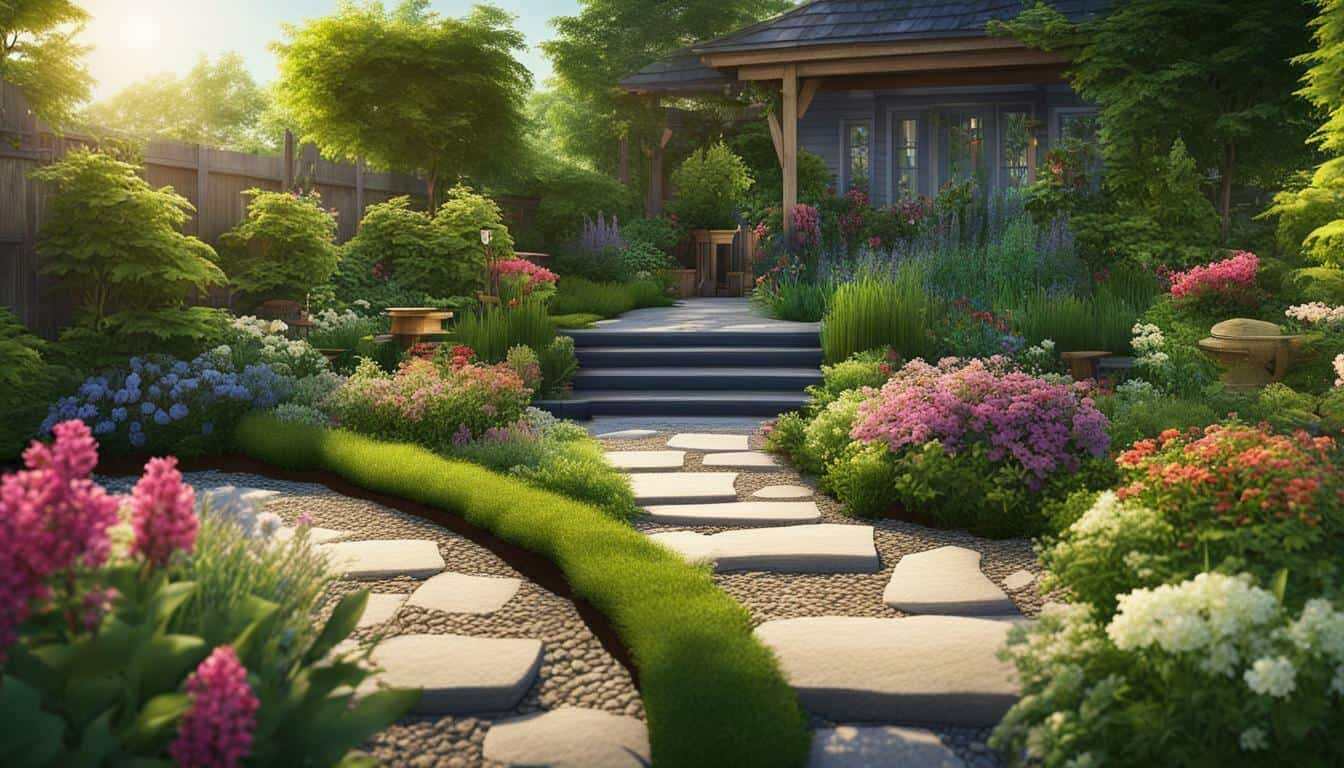



Leave a Reply